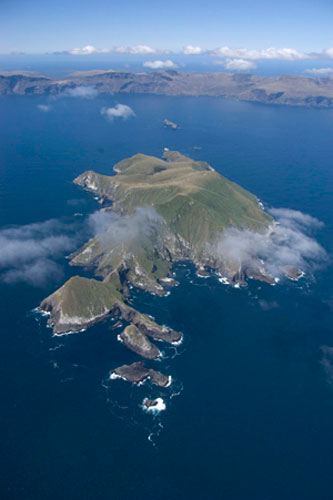The Near Threatened White-capped Albatross Thalassarche steadi is endemic to New Zealand, breeding on Disappointment, Adams and Auckland Islands in the Auckland Island group and Bollons Island (50-100 pairs) in the Antipodes Island Group. Population estimates suggest 95% of the global population breeds on Disappointment Island, an area where access is restricted to maintain environmental values at the site. Virtually all aspects of the biology and ecology of White-capped Albatrosses are poorly known and although approximate population sizes have developed there have been no well-documented population estimates for any of the colonies.

Between 2006-2010 Latitude 42 Environmental Consultants has undertaken a five-year project which aimed to conduct repeated population censuses of the White-capped Albatrosses breeding in the Auckland Islands using aerial photography. These population censuses were carried out to estimate population size and to follow population trends.
In 2010 the total population of White-capped Albatrosses was estimated to be 72 635 (95% CI 72 096 - 73 174), 4370 (4238 - 4502) and 117 (95 - 139) annual breeding pairs at Disappointment Island, South West Cape and Adams Island, respectively, giving a total for these sites of 76 913 (76 358 - 77 468) breeding pairs. The counts of nesting White-capped Albatrosses over the last four years have been significantly lower than the counts made in 2006, when a total of 117 197 annual breeding pairs was present at the Auckland Islands. These differences in counts may represent normal inter-annual variation in breeding rather than indicating a decline in numbers. However, in a global review of fisheries-related mortality of Shy T. cauta and White-capped Albatrosses it was estimated that 8000 White-capped Albatrosses were killed each year as a result of interactions with trawl and longline fisheries in the Southern Ocean. This level of mortality highlights the need to continue to acquire accurate population estimates and trends for White-capped Albatross populations to assess the impact of fisheries operations on this species.
Although annual counts over the last five years indicate the population may be in decline, further counts are recommended to clarify if this apparent trend is real, and if current levels of fishing mortality are sustainable.
Click here to read the report of the 2009 survey of White-capped Albatrosses by Latitude 42 Environmental Consultants.
With thanks to Barry Baker, Latitude 42 Environmental Consultants for information.
Reference:
Baker, G.B., Double, M.C., Gales, R., Tuck, G.N., Abbott, C.L., Ryan, P.G., Petersen, S.L., Robertson, C.J.R. & Alderman, R. 2007. A global assessment of the impact of fisheries-related mortality on Shy and White-capped Albatrosses: conservation implications. Biological Conservation 137: 319-333.

John Cooper, ACAP Information Officer, 7 August 2011

 Français
Français  English
English  Español
Español